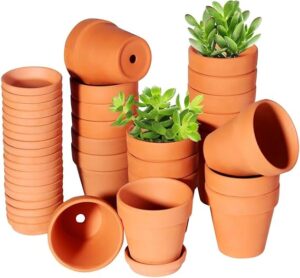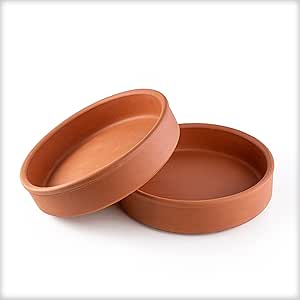
 The Charm and Benefits of Mud Pots: A Natural Touch for Your Home and Garden
The Charm and Benefits of Mud Pots: A Natural Touch for Your Home and Garden
In a world where modern technology often dominates, there’s something special about the simplicity and timeless beauty of mud pots. These humble, earth-made vessels have been used for centuries across cultures and regions, offering both practical and aesthetic benefits. Whether you’re gardening, cooking, or simply looking to add a rustic touch to your decor, mud pots can be a perfect choice. In this blog post, we’ll explore the advantages, uses, and care of mud pots, and why you should consider incorporating them into your home and garden.
What Are Mud Pots?
Mud pots, also known as clay pots or terracotta pots, are containers made from natural clay. The clay is shaped into pots, baked at high temperatures to harden, and left with a natural finish that showcases the earthy tones of the material. These pots have been a staple in various cultures, from Indian cooking pots and garden planters to traditional flower pots in Mediterranean and Asian gardens.
The beauty of mud pots lies in their simple, natural appearance, which can bring a sense of warmth and organic charm to any setting.
Why Choose Mud Pots?
There are many reasons why people opt for mud pots over plastic or ceramic alternatives. Here are a few compelling reasons to incorporate these earthy containers into your life:
1. Eco-Friendly
Mud pots are an environmentally friendly choice. Made from natural clay, they are biodegradable and do not contribute to plastic waste or other pollutants. Unlike plastic pots, which can leach chemicals into the soil over time, mud pots are completely natural and non-toxic.
2. Breathable for Plants
Mud pots are highly breathable, meaning they allow air to circulate through the walls of the pot. This is beneficial for plant roots, as it helps prevent them from becoming waterlogged. The porous nature of clay allows excess moisture to evaporate, which helps to maintain healthy root systems, making them ideal for plants that prefer well-drained soil.
3. Temperature Regulation
Clay pots are excellent at regulating the temperature of the soil. They help keep the roots cooler in the summer and warmer in the winter. This is particularly useful for plants that are sensitive to temperature fluctuations, helping them thrive in both indoor and outdoor environments.
4. Aesthetic Appeal
Mud pots have a rustic, earthy charm that can complement a variety of home and garden aesthetics. Their natural look works beautifully in both traditional and modern spaces. Whether you’re creating a minimalist garden or adding an organic touch to your home decor, mud pots can elevate your space with their simple beauty.
5. Durability
Clay pots are surprisingly durable, especially when compared to cheaper plastic alternatives. Though they can break if dropped, with proper care, mud pots can last for many years, often aging beautifully and developing a lovely patina over time. The longevity of mud pots makes them a great investment for gardening enthusiasts.
Uses of Mud Pots
Mud pots are incredibly versatile and can be used in many different ways, from functional to decorative. Here are some popular uses for these earth-based containers:
1. Garden Planters
One of the most common uses for mud pots is as planters for flowers, herbs, and vegetables. Their breathable nature makes them ideal for most garden plants, including succulents, cacti, tomatoes, and flowers. Larger clay pots are perfect for trees and shrubs, providing ample space for roots to spread.
2. Cooking Pots
In many parts of the world, mud pots (also known as handi or tandoor in some cultures) are used for cooking, particularly for slow-cooked dishes like stews, curries, and biryanis. The porous nature of the clay helps evenly distribute heat and retains moisture, giving your dishes a unique, rich flavor.
3. Indoor Decor
Mud pots can add a rustic, natural element to your home decor. Small mud pots can be used to hold indoor plants, creating a cozy, earthy vibe. Alternatively, they can serve as decorative items, such as candle holders, vases, or even unique storage containers for trinkets and small items.
4. Water Storage
In some cultures, mud pots are used to store water, particularly in rural areas where refrigeration isn’t common. The clay pot’s natural properties help keep water cool by allowing it to evaporate and regulate temperature, offering a refreshing drink on hot days.
5. Traditional Crafts
Mud pots are sometimes used in crafting, particularly in creating artistic and decorative pieces. Artists can paint or carve the surface to create unique, handmade items. These can range from small ornaments and sculptures to large, functional pots and vessels.
How to Care for Mud Pots
While mud pots are durable, they do require some basic care to ensure they remain in good condition and continue to serve their purpose effectively.
1. Avoid Direct Sunlight
Although mud pots are good at regulating temperature, they can crack if exposed to excessive heat or direct sunlight for long periods. When placed outside, make sure they are in a shaded spot or an area with some protection from harsh weather.
2. Watering Properly
Because mud pots are porous, it’s important to monitor watering closely. They can dry out faster than plastic pots, so be sure to keep the soil consistently moist, but not soggy. Be careful not to overwater, as the water can quickly evaporate through the sides of the pot.
3. Handle with Care
While mud pots are sturdy, they can be fragile if dropped. Always handle with care, especially when moving or repositioning them in the garden. If the pot does break, it can often be repaired with strong adhesives, though it’s usually best to replace it if the damage is extensive.
4. Cleaning
To clean a mud pot, simply rinse it with warm water. Avoid using harsh chemicals or scrubbing pads that could scratch the surface. If there’s mineral buildup or residue, a mixture of water and vinegar can help remove stubborn stains. Always dry your pot thoroughly before reusing it.
5. Storage for Winter
If you live in a region with cold winters, it’s important to bring your clay pots indoors during the colder months. The freezing and thawing cycles can cause the pots to crack. Store them in a dry, cool location when not in use to extend their lifespan.
Conclusion
Mud pots are more than just containers – they are a testament to the beauty of simplicity and nature. Whether you’re using them for gardening, cooking, or decorating your home, these natural vessels offer numerous benefits that other materials simply can’t match. From their eco-friendly properties to their ability to regulate temperature and encourage healthy plant growth, mud pots are a great investment for anyone looking to bring a little bit of the earth’s charm into their daily life.
So, the next time you’re looking for a plant pot, cooking vessel, or even a decorative item for your home, consider choosing a mud pot. Not only will it add beauty and warmth to your space, but it will also connect you to a centuries-old tradition of using natural materials for practical and artistic purposes.





